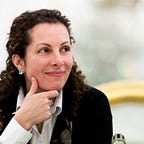Sam Altman, One True Leader and the Missed Opportunity for Innovation
Reposted from The Reboot Democracy Blog
In his forthcoming and beautifully-written review in Constitutional Commentary of Steven Levitsky and Daniel Ziblatt’s new book Tyranny of the Minority, San Diego Law School Professor Laurence Claus asks why the authors’ prescription for democratic reform neglects to address what he calls the “one true leader.” The One True Leader refers to the office of the chief executive.
“Many people can become in thrall to a person,” Claus writes. “No one has ever been in thrall to a committee. If we don’t want one person at the top for life, then how about not having one person at the top at all?”
If we are worried about authoritarianism, why are we failing to innovate in the one arena that puts us most at risk of populist take over: the presidency?
I live in a town that does not have a Mayor. My community is governed by a five-member Select Board and an elected town meeting and yet the trash still gets taken out. Switzerland has long had a federal council and lived in peace and prosperity.
It’s such a simple question and yet one that rarely gets asked. If the office of the chief executive creates all the risk of democratic subversion, why do we content ourselves by tinkering with an anemic and fragile oversight system instead of fixing the root cause of the problem? If we can have multi-member courts and legislatures, why not a plural executive? Claus rightly challenges us to answer why we do so little to reinvent the role of the charismatic leader.
To be sure, simply replacing the one with the few, especially where there is a risk of one-party dominance, does not solve all the problems.
As we saw with the unfolding drama at OpenAI this week, the unitary leader holds a great deal of appeal. Perhaps had the board been more forthcoming, transparent and democratic in how it functioned, the story might have had a different ending. There was a failed opportunity to reimagine governance using the very tools that OpenAI creates. Had the board really desired to rein in tech dangers and create more open and accountable governance, why not dramatically expand representation and participation? Why not use AI to engage more people in decision making? Why not take advantage of the tools’ efficiencies to foster a more open conversation? Why not at least announce a period of reflection and listening to invent and reimagine alternatives?
It’s disappointing, to say the least, that OpenAI’s only experiments with democracy thus far involve replicating toothless deliberative assemblies that have no power instead of exploring meaningful ways of engaging the broader public and diverse experts to improve decision making. So much money going into R&D and yet nothing being spent on the democratic innovations that AI could enable.
We are overdue for a conversation about “the one true leader” in the boardroom and in the White House. Alternatives have long been dismissed as inefficient and ineffectual. But the assumptions that undergirded those conclusions are hardly true any longer in the age of AI.
As we navigate the complexities of leadership in the age of AI and beyond, the question of how we structure our systems of governance — both in politics and in our organizations — remains crucial. The allure of the one true leader may be a familiar path, but it’s one fraught with risks of authoritarianism and inefficiency in a rapidly evolving world. The examples of collective leadership, from local town councils to nations like Switzerland, offer a glimpse into the potential of a more distributed, democratic approach. It’s time we ask ourselves: Are we ready to challenge the long-held assumptions about leadership and embrace innovative models that could better serve our societies in the digital era? The future may depend on our willingness to rethink the very notion of power and authority, leveraging the tools and insights of our time to forge more resilient, inclusive, and effective governance structures.
